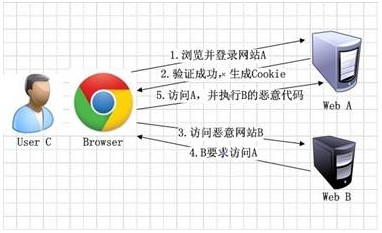csrf攻擊過程

1.用戶C打開瀏覽器,訪問受信任網(wǎng)站A,輸入用戶名和密碼請求登錄網(wǎng)站A;
2.在用戶信息通過驗證后,網(wǎng)站A產(chǎn)生Cookie信息并返回給瀏覽器,此時用戶登錄網(wǎng)站A成功,可以正常發(fā)送請求到網(wǎng)站A;
3.用戶未退出網(wǎng)站A之前,在同一瀏覽器中,打開一個TAB頁訪問網(wǎng)站B;
4.網(wǎng)站B接收到用戶請求后,返回一些攻擊性代碼,并發(fā)出一個請求要求訪問第三方站點A;
5.瀏覽器在接收到這些攻擊性代碼后,根據(jù)網(wǎng)站B的請求,在用戶不知情的情況下攜帶Cookie信息,向網(wǎng)站A發(fā)出請求。網(wǎng)站A并不知道該請求其實是由B發(fā)起的,所以會根據(jù)用戶C的Cookie信息以C的權(quán)限處理該請求,導(dǎo)致來自網(wǎng)站B的惡意代碼被執(zhí)行。
csrf的攻擊之所以會成功是因為服務(wù)器端身份驗證機制可以通過Cookie保證一個請求是來自于某個用戶的瀏覽器,但無法保證該請求是用戶允許的。因此,預(yù)防csrf攻擊簡單可行的方法就是在客戶端網(wǎng)頁上添加隨機數(shù),在服務(wù)器端進行隨機數(shù)驗證,以確保該請求是用戶允許的。Django也是通過這個方法來防御csrf攻擊的。
在django防御csrf攻擊
原理
在客戶端頁面上添加csrftoken, 服務(wù)器端進行驗證,服務(wù)器端驗證的工作通過'django.middleware.csrf.CsrfViewMiddleware'這個中間層來完成。在django當(dāng)中防御csrf攻擊的方式有兩種, 1.在表單當(dāng)中附加csrftoken 2.通過request請求中添加X-CSRFToken請求頭。注意:Django默認對所有的POST請求都進行csrftoken驗證,若驗證失敗則403錯誤侍候。
在表單中附加csrftoken
后端
from django.shortcuts import render
from django.template.context_processors import csrf
def ajax_demo(request):
# csrf(request)構(gòu)造出{‘csrf_token’: token}
return render(request, 'post_demo.html', csrf(request))
前端
$('#send').click(function(){
$.ajax({
type: 'POST',
url:'{% url 'ajax:post_data' %}',
data: {
username: $('#username').val(),
content: $('#content').val(),
'csrfmiddlewaretoken': '{{ csrf_token }}' 關(guān)鍵點
},
dataType: 'json',
success: function(data){
},
error: function(){
}
});
});
通過request請求中添加X-CSRFToken請求頭
后端
該方式需要借助于Cookie傳遞csrftoken, 設(shè)置Cookie的方式有兩種。ps:經(jīng)測試即便什么都不做,也會設(shè)置Cookie,不過官方文檔說,不保證每次都有效
1.表單中添加{%csrf_token%}這個模板標簽
<form id="comment_form" action="#"></form>
{% csrf_token %} 就是這個
<p>姓名: <input type="text" name="useranme" id="username"></p>
<p>內(nèi)容: <textarea name="content" id="content" rows="5" cols="30"></textarea></p>
<p><input type="button", id="send" value="提交"></p>
2.ensure_csrf_cookie裝飾器。
from django.shortcuts import render
from django.views.decorators.csrf import ensure_csrf_cookie
@ensure_csrf_cookie
def ajax_demo(request):
return render(request, 'ajax_demo.html')
前端
前端要做的事情,在進行post提交時,獲取Cookie當(dāng)中的csrftoken并在請求中添加X-CSRFToken請求頭, 該請求頭的數(shù)據(jù)就是csrftoken。通過$.ajaxSetup方法設(shè)置AJAX請求的默認參數(shù)選項, 在每次ajax的POST請求時,添加X-CSRFToken請求頭
<script type="text/javascript">
$(function(){
function getCookie(name) {
var cookieValue = null;
if (document.cookie && document.cookie != '') {
var cookies = document.cookie.split(';');
for (var i = 0; i < cookies.length; i++) {
var cookie = jQuery.trim(cookies[i]);
// Does this cookie string begin with the name we want?
if (cookie.substring(0, name.length + 1) == (name + '=')) {
cookieValue = decodeURIComponent(cookie.substring(name.length + 1));
break;
}
}
}
return cookieValue;
}
<!--獲取csrftoken-->
var csrftoken = getCookie('csrftoken');
console.log(csrftoken);
//Ajax call
function csrfSafeMethod(method) {
// these HTTP methods do not require CSRF protection
return (/^(GET|HEAD|OPTIONS|TRACE)$/.test(method));
}
$.ajaxSetup({
crossDomain: false, // obviates need for sameOrigin test
//請求前觸發(fā)
beforeSend: function(xhr, settings) {
if (!csrfSafeMethod(settings.type)) {
xhr.setRequestHeader("X-CSRFToken", csrftoken);
}
}
});
$('#send').click(function(){
console.log($("#comment_form").serialize());
$.ajax({
type: 'POST',
url:'{% url 'ajax:post_data' %}',
data: {
username: $('#username').val(),
content: $('#content').val(),
//'csrfmiddlewaretoken': '{{ csrf_token }}'
},
dataType: 'json',
success: function(data){
},
error: function(){
}
});
});
});
</script>
取消csrftoken驗證
通過csrf_exempt, 來取消csrftoken驗證,方式有兩種。
1 .在視圖函數(shù)當(dāng)中添加csrf_exempt裝飾器
from django.views.decorators.csrf import csrf_exempt
@csrf_exempt
def post_data(request):
pass
2 .在urlconf當(dāng)中
from django.views.decorators.csrf import csrf_exempt
urlpatterns = [
url(r'^post/get_data/$', csrf_exempt(post_data), name='post_data'),
]